Abstract
Graded doses of 0.6, 1.3, and 3.3 pmol/kg/min of vasoactive intestinal peptide (VIP) were intravenously infused over 30 minute periods in four healthy volunteers and plasma VIP levels were measured by radioimmunoassay. Even with the smallest dose of VIP, plasma concentrations rose markedly above normal values. Infusion of higher VIP doses resulted in mean plateau levels of circulating VIP which were in the range of VIP values found in the Verner-Morrison syndrome. After cessation of the VIP infusions, plasma VIP levels fell strikingly by first order kinetics with an average disappearance half-time of one minute. The apparent metabolic clearance rate was about 9 ml/kg/min and the apparent volume of distribution for VIP was approximately 14 ml/kg. During infusion of the highest VIP dose, previously shown to induce one-fifth maximum pancreatic juice secretion, plasma concentrations of glucose, free fatty acids, and calcium were slightly but significantly raised, the pulse rate and the amplitude of blood pressure were increased, and cutaneous flushing occurred. The spectrum of effects accords well with some abnormalities seen in the Verner-Morrison syndrome. The present data, however, do not support a role for VIP as a circulating hormone, at least under physiological conditions.
Full text
PDF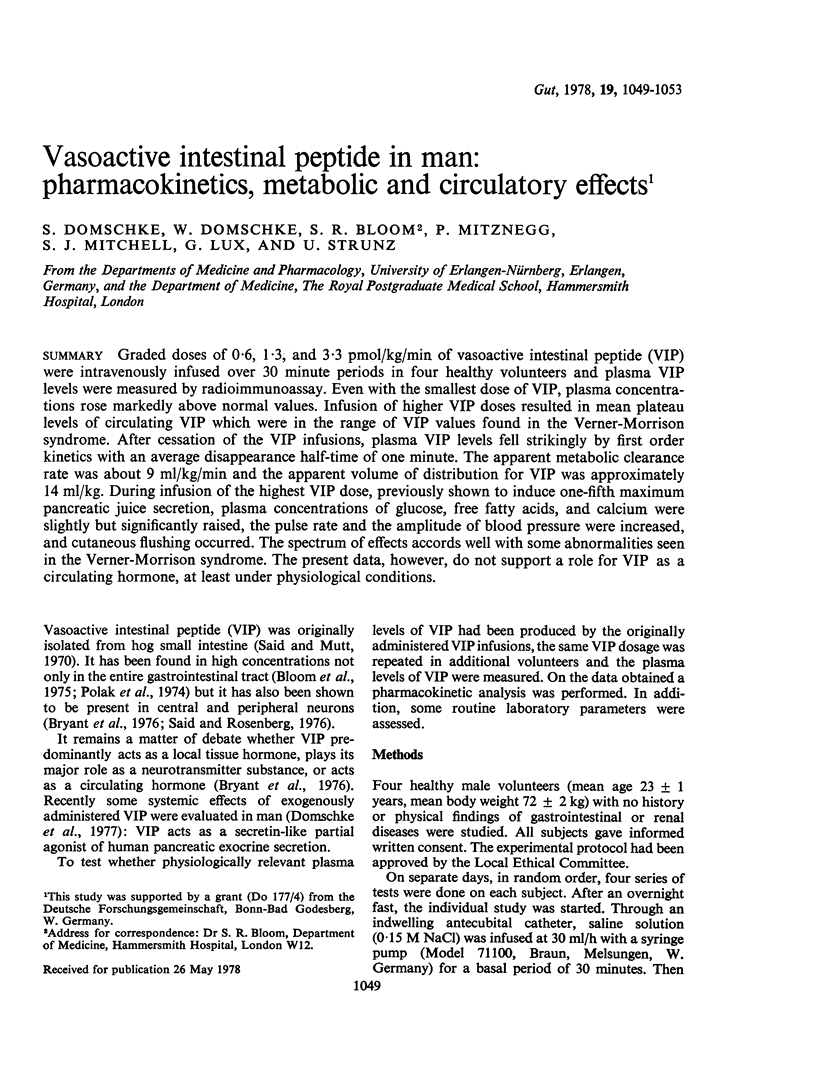
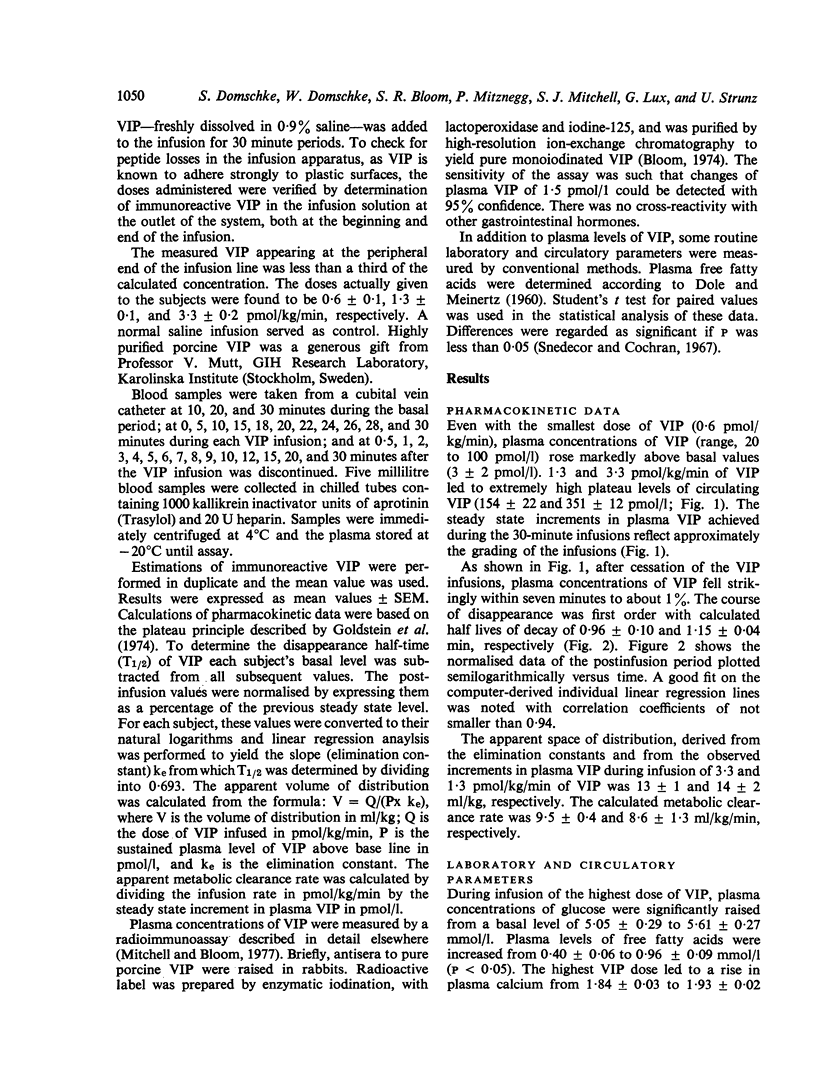
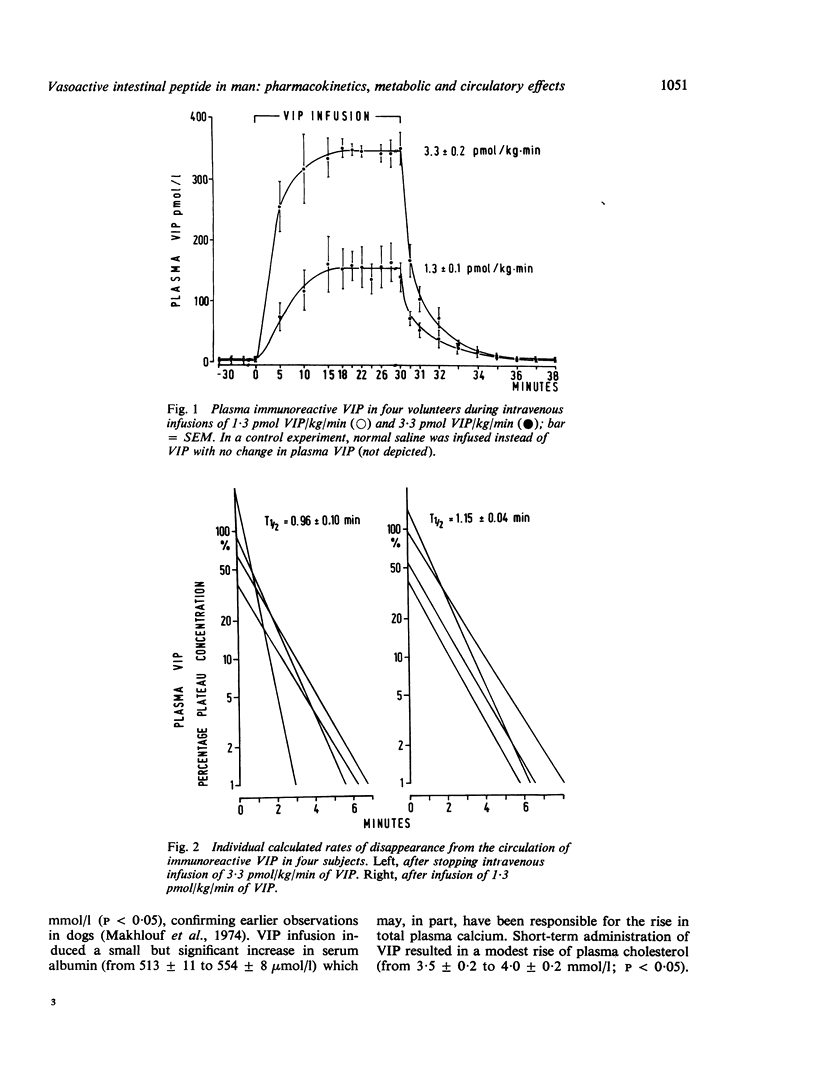
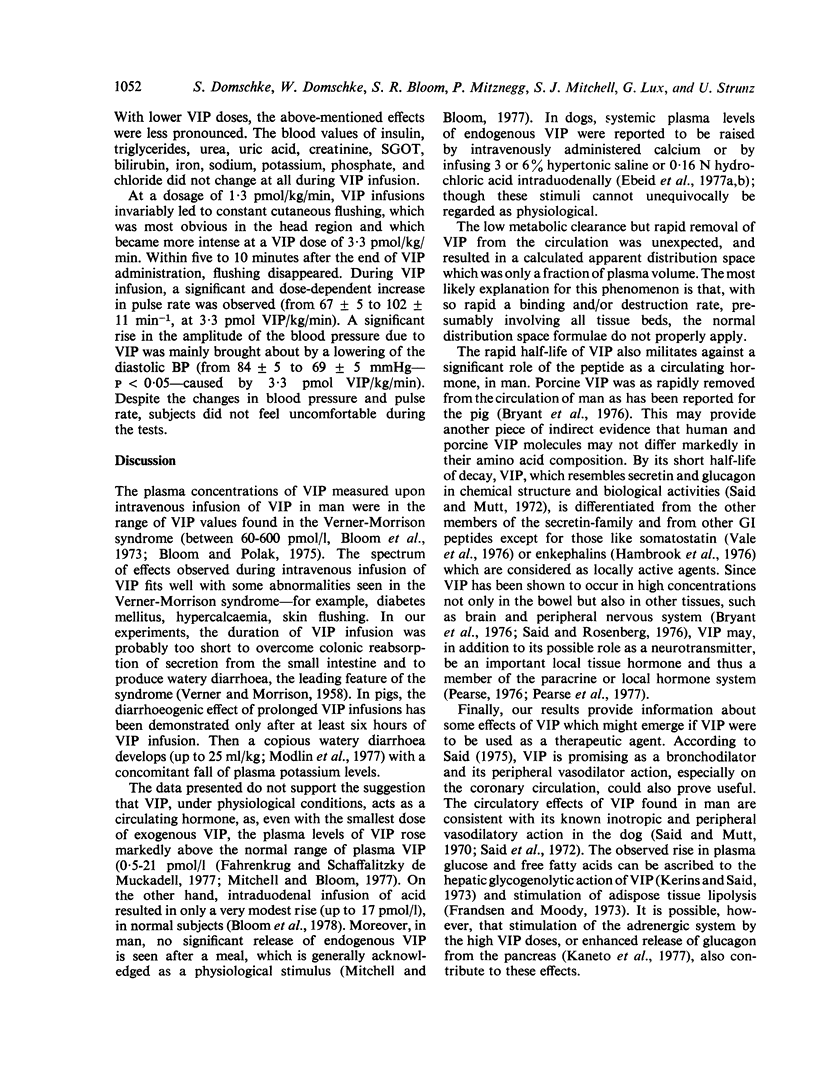
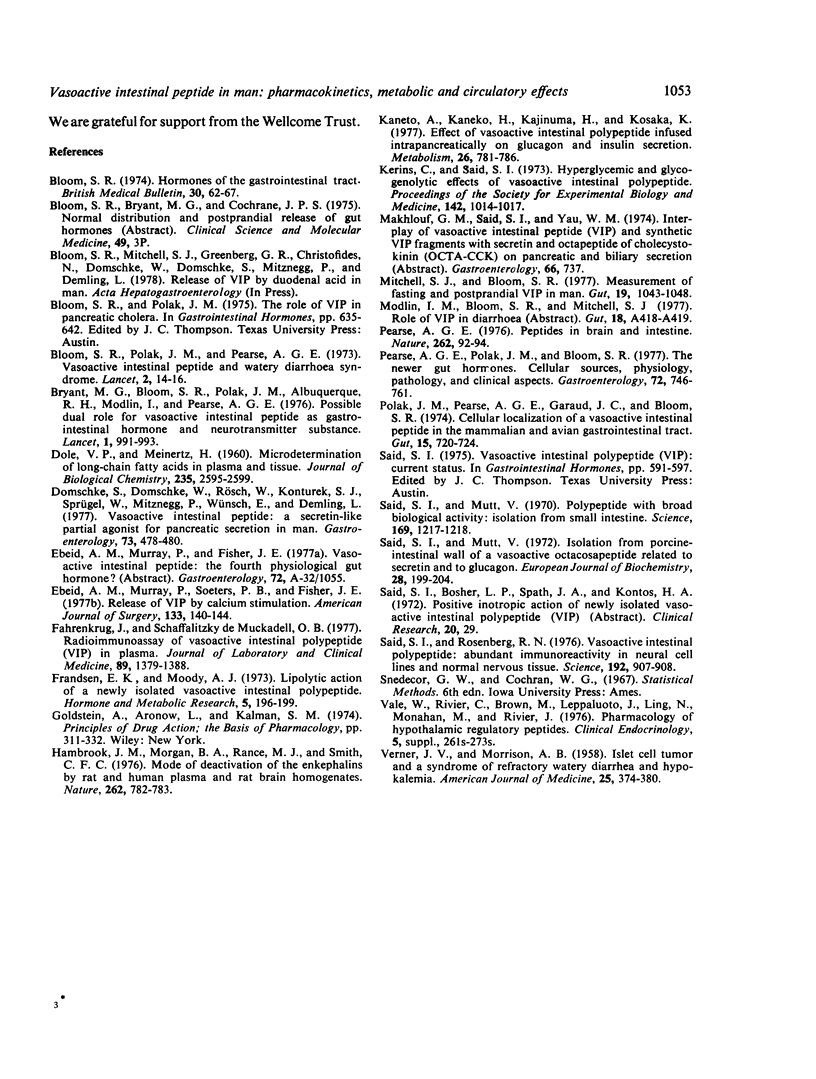
Selected References
These references are in PubMed. This may not be the complete list of references from this article.
- Bloom S. R. Hormones of the gastrointestinal tract. Br Med Bull. 1974 Jan;30(1):62–67. doi: 10.1093/oxfordjournals.bmb.a071169. [DOI] [PubMed] [Google Scholar]
- Bloom S. R., Polak J. M., Pearse A. G. Vasoactive intestinal peptide and watery-diarrhoea syndrome. Lancet. 1973 Jul 7;2(7819):14–16. doi: 10.1016/s0140-6736(73)91947-8. [DOI] [PubMed] [Google Scholar]
- Bryant M. G., Polak M. M., Modlin I., Bloom S. R., Albuquerque R. H., Pearse A. G. Possible dual role for vasoactive intestinal peptide as gastrointestinal hormone and neurotransmitter substance. Lancet. 1976 May 8;1(7967):991–993. doi: 10.1016/s0140-6736(76)91863-8. [DOI] [PubMed] [Google Scholar]
- DOLE V. P., MEINERTZ H. Microdetermination of long-chain fatty acids in plasma and tissues. J Biol Chem. 1960 Sep;235:2595–2599. [PubMed] [Google Scholar]
- Domschke S., Domschke W., Rösch W., Konturek S. J., Sprügel W., Mitznegg P., Wünsch E., Demling L. Vasoactive intestinal peptide: a secretin-like partial agonist for pancreatic secretion in man. Gastroenterology. 1977 Sep;73(3):478–480. [PubMed] [Google Scholar]
- Ebeid A. M., Murray P., Soeters P. B., Fischer J. E. Release of VIP by calcium stimulation. Am J Surg. 1977 Jan;133(1):140–144. doi: 10.1016/0002-9610(77)90208-2. [DOI] [PubMed] [Google Scholar]
- Fahrenkrug J., Schaffalitzky de Muckadell O. V. Radioimmunoassay of vasoactive intestinal polypeptide (VIP) in plasma. J Lab Clin Med. 1977 Jun;89(6):1379–1388. [PubMed] [Google Scholar]
- Frandsen E. K., Moody A. J. Lipolytic action of a newly isolated vasoactive intestinal polypeptide. Horm Metab Res. 1973 May;5(3):196–199. doi: 10.1055/s-0028-1093951. [DOI] [PubMed] [Google Scholar]
- Hambrook J. M., Morgan B. A., Rance M. J., Smith C. F. Mode of deactivation of the enkephalins by rat and human plasma and rat brain homogenates. Nature. 1976 Aug 26;262(5571):782–783. doi: 10.1038/262782a0. [DOI] [PubMed] [Google Scholar]
- Kaneto A., Kaneko T., Kajinuma H., Kosaka K. Effect of vasoactive intestinal polypeptide infused intrapancreatically on glucagon and insulin secretion. Metabolism. 1977 Jul;26(7):781–786. doi: 10.1016/0026-0495(77)90065-8. [DOI] [PubMed] [Google Scholar]
- Kerins C., Said S. I. Hyperglycemic and glycogenolytic effects of vasoactive intestinal polypeptide. Proc Soc Exp Biol Med. 1973 Mar;142(3):1014–1017. doi: 10.3181/00379727-142-37165. [DOI] [PubMed] [Google Scholar]
- Mitchell S. J., Bloom S. R. Measurement of fasting and postprandial plasma VIP in man. Gut. 1978 Nov;19(11):1043–1048. doi: 10.1136/gut.19.11.1043. [DOI] [PMC free article] [PubMed] [Google Scholar]
- Pearse A. G., Polak J. M., Bloom S. R. The newer gut hormones. Cellular sources, physiology, pathology, and clinical aspects. Gastroenterology. 1977 Apr;72(4 Pt 1):746–761. [PubMed] [Google Scholar]
- Polak J. M., Pearse A. G., Garaud J. C., Bloom S. R. Cellular localization of a vasoactive intestinal peptide in the mammalian and avian gastrointestinal tract. Gut. 1974 Sep;15(9):720–724. doi: 10.1136/gut.15.9.720. [DOI] [PMC free article] [PubMed] [Google Scholar]
- Said S. I., Mutt V. Isolation from porcine-intestinal wall of a vasoactive octacosapeptide related to secretin and to glucagon. Eur J Biochem. 1972 Jul 13;28(2):199–204. doi: 10.1111/j.1432-1033.1972.tb01903.x. [DOI] [PubMed] [Google Scholar]
- Said S. I., Mutt V. Polypeptide with broad biological activity: isolation from small intestine. Science. 1970 Sep 18;169(3951):1217–1218. doi: 10.1126/science.169.3951.1217. [DOI] [PubMed] [Google Scholar]
- Said S. I., Rosenberg R. N. Vasoactive intestinal polypeptide: abundant immunoreactivity in neural cell lines and normal nervous tissue. Science. 1976 May 28;192(4242):907–908. doi: 10.1126/science.1273576. [DOI] [PubMed] [Google Scholar]
- VERNER J. V., MORRISON A. B. Islet cell tumor and a syndrome of refractory watery diarrhea and hypokalemia. Am J Med. 1958 Sep;25(3):374–380. doi: 10.1016/0002-9343(58)90075-5. [DOI] [PubMed] [Google Scholar]
- Vale W., Rivier C., Brown M., Leppaluoto J., Ling N., Monahan M., Rivier J. Pharmacology of hypothalamic regulatory peptides. Clin Endocrinol (Oxf) 1976;5 (Suppl):261S–273S. doi: 10.1111/j.1365-2265.1976.tb03834.x. [DOI] [PubMed] [Google Scholar]


